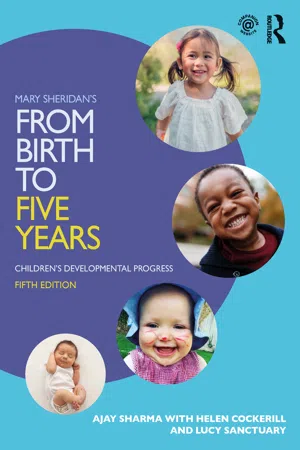
Mary Sheridan's From Birth to Five Years
Children's Developmental Progress
- 14 pages
- English
- ePUB (mobile friendly)
- Available on iOS & Android
Mary Sheridan's From Birth to Five Years
Children's Developmental Progress
About this book
This new edition of a classic text is the go-to reference for anyone concerned with the developmental progress of pre-school children. It provides the knowledge required for understanding children's developmental progress with age and within each developmental domain.
Including new sections on atypical development for each of the core domains of development and additional material on the development of attention and self-regulation, this fifth edition integrates findings from the latest research throughout. An updated companion website is available at www.routledge.com/cw/sharma, which includes the following additional learning material: an interactive timeline of the key developmental domains; introductions to theory with links to further reading; research summaries; video clips demonstrating practical assessment skills; downloadable resources including pictures to support examination of verbal and non-verbal development, and tips to facilitate and promote development.
Fully aligned with current child development philosophies and practices, Mary Sheridan's From Birth to Five Years: Children's Developmental Progress is designed to support the wider group of practitioners – including those from health professions, social work and early years – that are now required to take steps for promoting children's development as part of their assessment and management plans.
Frequently asked questions
- Essential is ideal for learners and professionals who enjoy exploring a wide range of subjects. Access the Essential Library with 800,000+ trusted titles and best-sellers across business, personal growth, and the humanities. Includes unlimited reading time and Standard Read Aloud voice.
- Complete: Perfect for advanced learners and researchers needing full, unrestricted access. Unlock 1.4M+ books across hundreds of subjects, including academic and specialized titles. The Complete Plan also includes advanced features like Premium Read Aloud and Research Assistant.
Please note we cannot support devices running on iOS 13 and Android 7 or earlier. Learn more about using the app.
Information
Section 1
Illustrated charts of children’s developmental progress

The newborn baby

Alertness and responsiveness
Social interaction

Sensory: Touch, smell and taste
Sensory: Hearing and vision
Posture and large movements

- When lying on the back (supine), arms and legs are kept partially flexed. However, babies born after breech presentation tend to keep their legs extended.
- When the in...
Table of contents
- Cover
- Half-Title
- Title
- Copyright
- Contents
- A visual tour of the book
- Companion website
- Introduction
- SECTION 1 Illustrated charts of children’s developmental progress
- SECTION 2 Domains of development
- Glossary
- References
- Index